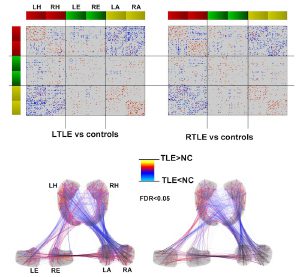Abstract
Temporal lobe epilepsy (TLE) is the most frequent drug-resistant epilepsy in adults and commonly associated with variable degrees of mesiotemporal atrophy on magnetic resonance imaging (MRI). Analyses of inter-regional connectivity have unveiled disruptions in large-scale cortico-cortical networks; little is known about the topological organization of the mesiotemporal lobe, the limbic subnetwork central to the disorder. We generated covariance networks based on high-resolution MRI surface-shape descriptors of the hippocampus, entorhinal cortex, and amygdala in 134 TLE patients and 45 age- and sex-matched controls. Graph-theoretical analysis revealed increased path length and clustering in patients, suggesting a shift toward a more regularized arrangement; findings were reproducible after split-half assessment and across 2 parcellation schemes. Analysis of inter-regional correlations and module participation showed increased within-structure covariance, but decreases between structures, particularly with regards to the hippocampus and amygdala. While higher clustering possibly reflects topological consequences of axonal sprouting, decreases in interstructure covariance may be a consequence of disconnection within limbic circuitry. Preoperative network parameters, specifically the segregation of the ipsilateral hippocampus, predicted long-term seizure freedom after surgery.

